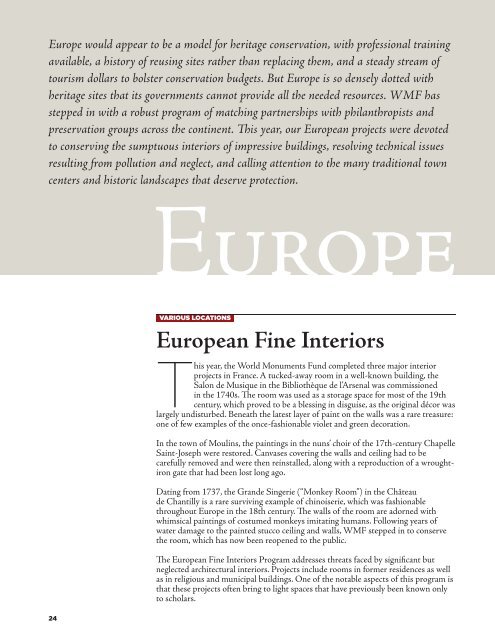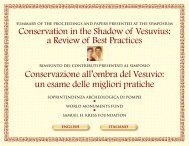2008 Annual Report - World Monuments Fund
2008 Annual Report - World Monuments Fund
2008 Annual Report - World Monuments Fund
Create successful ePaper yourself
Turn your PDF publications into a flip-book with our unique Google optimized e-Paper software.
Europe would appear to be a model for heritage conservation, with professional training<br />
available, a history of reusing sites rather than replacing them, and a steady stream of<br />
tourism dollars to bolster conservation budgets. But Europe is so densely dotted with<br />
heritage sites that its governments cannot provide all the needed resources. WMF has<br />
stepped in with a robust program of matching partnerships with philanthropists and<br />
preservation groups across the continent. This year, our European projects were devoted<br />
to conserving the sumptuous interiors of impressive buildings, resolving technical issues<br />
resulting from pollution and neglect, and calling attention to the many traditional town<br />
centers and historic landscapes that deserve protection.<br />
Europe<br />
24<br />
various loCations<br />
European Fine Interiors<br />
This year, the <strong>World</strong> <strong>Monuments</strong> <strong>Fund</strong> completed three major interior<br />
projects in France. A tucked-away room in a well-known building, the<br />
Salon de Musique in the Bibliothèque de l’Arsenal was commissioned<br />
in the 1740s. The room was used as a storage space for most of the 19th<br />
century, which proved to be a blessing in disguise, as the original décor was<br />
largely undisturbed. Beneath the latest layer of paint on the walls was a rare treasure:<br />
one of few examples of the once-fashionable violet and green decoration.<br />
In the town of Moulins, the paintings in the nuns’ choir of the 17th-century Chapelle<br />
Saint-Joseph were restored. Canvases covering the walls and ceiling had to be<br />
carefully removed and were then reinstalled, along with a reproduction of a wroughtiron<br />
gate that had been lost long ago.<br />
Dating from 1737, the Grande Singerie (“Monkey Room”) in the Château<br />
de Chantilly is a rare surviving example of chinoiserie, which was fashionable<br />
throughout Europe in the 18th century. The walls of the room are adorned with<br />
whimsical paintings of costumed monkeys imitating humans. Following years of<br />
water damage to the painted stucco ceiling and walls, WMF stepped in to conserve<br />
the room, which has now been reopened to the public.<br />
The European Fine Interiors Program addresses threats faced by significant but<br />
neglected architectural interiors. Projects include rooms in former residences as well<br />
as in religious and municipal buildings. One of the notable aspects of this program is<br />
that these projects often bring to light spaces that have previously been known only<br />
to scholars.
















